
Connex Melbourne was a train operator in Melbourne, Australia. Formed in July 1998 as Hillside Trains, a business unit of the Public Transport Corporation, it was privatised in August 1999 becoming a subsidiary of Connex.
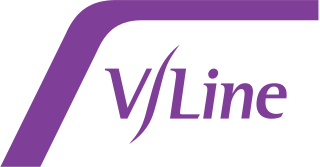
V/Line is a statutory authority that operates regional passenger train and coach services in the Australian state of Victoria. It provides passenger train services on five commuter lines and eight long-distance routes from its major hub at Southern Cross railway station in Melbourne. It also provides bus services across Victoria and into New South Wales, the Australian Capital Territory and South Australia. In addition, V/Line is responsible for the maintenance of much of the Victorian freight and passenger rail network outside of the areas managed by Metro Trains Melbourne and the Australian Rail Track Corporation.

The Hitachi was an electric multiple unit that operated on the Melbourne suburban railway network between 1972 and 2014. Electrical equipment was supplied by Commonwealth Engineering to designs by Hitachi of Japan, leading to their official name today, though no actual Hitachi-supplied components were used in their construction. They were the last suburban trains in Melbourne with no air conditioning. A total of 355 carriages were built between 1972 and 1981, including a replacement carriage for one written off while the fleet was still being delivered.

The Comeng train is a type of electric multiple unit (EMU) that operates on the suburban railway network of Melbourne, Victoria, Australia. Built by Commonwealth Engineering (Comeng) in Dandenong, they were introduced in 1981 as a replacement for the Tait and Harris trains. In total, 570 carriages were built.

Freight Australia was an Australian railway company that purchased the V/Line Freight business from the Government of Victoria in 1999. Initially known as Freight Victoria, it operated rail freight services and controlled non-urban rail track in the state of Victoria, later expanding into freight haulage in other states. Freight Australia was sold to Pacific National in August 2004.
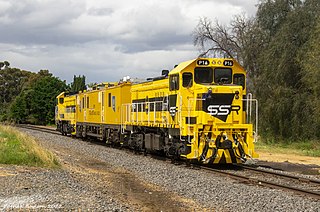
Southern Shorthaul Railroad is an Australian rail freight services operator in New South Wales and Victoria. The company also provides workshop services, such as rolling stock manufacturing and wagon and locomotive maintenance.

The V/Line VLocity, sometimes called the VLocity 160, is a diesel multiple unit train built by Alstom in Dandenong for V/Line, the regional rail operator in the Australian state of Victoria. Continuously in production since 2003, the VLocity is the highest-speed train in the V/Line fleet, with a top speed of 160 km/h (99 mph). As of December 2023 with set 114 entering service, 112 3-car sets are in revenue service, 2 collision damaged sets are in storage, and 5 more are under construction on the current order with a further 23 sets confirmed on the next order
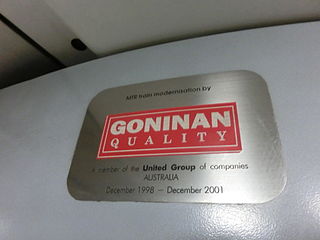
UGL Rail is an Australian rail company specialising in building, maintaining and refurbishing diesel locomotives, diesel and electric multiple units and freight wagons. It is a subsidiary of UGL Limited and is based in Melbourne, with a staff of 1,200 across Australia and Asia. It operates factories in Broadmeadow, Maintrain Auburn, Spotswood and Bassendean. While it used to operate a factory in Taree, the plant was shut down and the equipment sold off.

Ballarat railway station is located on the Serviceton line in Victoria, Australia. It serves the city of Ballarat, and opened on 11 April 1862 as Ballarat West. It was renamed Ballarat in 1865.
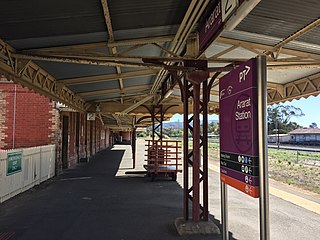
Ararat railway station is located on the Serviceton and Western standard gauge lines in Victoria, Australia. It serves the town of Ararat, and opened on 7 April 1875.

Maryborough railway station is located on the Mildura line in Victoria, Australia. It serves the town of Maryborough, and it opened on 7 July 1874.

The N Class are a class of diesel locomotives built by Clyde Engineering in Somerton for V/Line between 1985 and 1987.
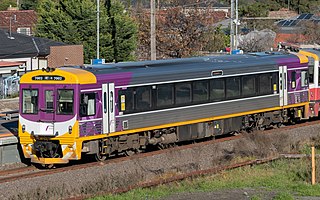
The Sprinter is a diesel railcar built by A Goninan & Co in Broadmeadow, NSW for V/Line between 1993 and 1995.

The Newport Railway Workshops is a facility in the Melbourne suburb of Newport, Australia, that builds, maintains and refurbishes railway rollingstock. It is located between the Williamstown and Werribee railway lines.
Bendigo Workshops is a railway workshop in Bendigo, Victoria, Australia. It is located in the north of the city beside the junction of the Yungera and Deniliquin railway lines. The site covers 10.3 hectares of land and has 31 separate buildings, including a 10,000 sqm main workshop building and six kilometres of railway track.

Jolimont Workshops was a railway workshop operated by the Victorian Railways beside Jolimont Yard, near the Melbourne CBD, Australia. Opened in 1917 and dedicated to the maintenance and repair of electric multiple units and locomotives, it was the first part of the yard to be closed and relocated, with demolition completed in 1994. The site is now part of the Melbourne Park tennis complex.
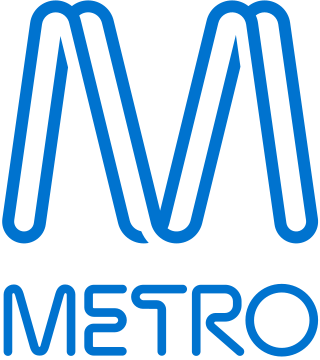
Metro Trains Melbourne, often known simply as Metro, is the operator and brand name of train services on the electrified metropolitan rail network serving the city of Melbourne, Victoria, Australia. It is the largest urban rail network in Australia, with 17 lines and 219 stations across 405 km (252 mi) of railways, and the second busiest network in Australia, with a patronage of 99.5 million as of 2021–2022.

South Dynon Locomotive Depot is an Australian locomotive depot in Melbourne, purpose built for the servicing of diesel and electric locomotives by the Victorian Railways opening in July 1961.

The X'Trapolis 2.0 is a series of electric multiple unit (EMU) trains to be used for Metro Trains Melbourne, part of Alstom's X'Trapolis family. The trains are set to enter service between 2024 and 2026.

The G-class Melbourne tram is a three-section articulated tram, to be introduced onto the Melbourne tram network in 2025. The trams will be low-floor, replacing the Z-class and A-class trams, which will help improve passenger accessibility across the network. The design is based on the Flexity 2 but with pivoting outer bogies.






















